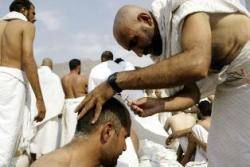The first ruling: Changing the Ihraam clothes
When a man or woman is in the state of Ihraam (sacral state), whether for Hajj or ‘Umrah (minor pilgrimage), it is permissible to change the clothes with which he/she started the state of Ihraam and to wear other clothes, provided that they are permissible to be worn during Ihraam. One is also permitted to wear sandals even if he started Ihraam while barefoot.
The second ruling: The place where the two Rak'ahs after Tawaaf should be performed
After Tawaaf (circumambulating the Ka‘bah), it is recommended that one offers a two-Rak'ah (unit) prayer behind the Station of Ibraaheem (Abraham) ![]() . When the area near the Station is accessible and not crowded, one should pray there. Otherwise, one can pray at any other place while having the Station before him while facing the Ka‘bah. In doing so, he fulfills the obligation of praying behind the Station and complies with the Sunnah (tradition) of the Prophet
. When the area near the Station is accessible and not crowded, one should pray there. Otherwise, one can pray at any other place while having the Station before him while facing the Ka‘bah. In doing so, he fulfills the obligation of praying behind the Station and complies with the Sunnah (tradition) of the Prophet ![]() in performing Hajj. Describing the way the Prophet
in performing Hajj. Describing the way the Prophet ![]() performed Hajj, Jaabir
performed Hajj, Jaabir ![]() narrated that the Prophet
narrated that the Prophet ![]() stood behind the Station of Ibraaheem
stood behind the Station of Ibraaheem ![]() while facing the Ka‘bah.
while facing the Ka‘bah.
The third ruling: Performing Sa'y and Tawaaf with no intervals
It is better that Sa'y (seven rounds between Mount As-Safa and Al-Marwah) is performed immediately after Tawaaf. However, it is permissible to postpone it, even for a long time, as when one performs Tawaaf at the beginning of the day and then performs Sa'y at the end, or when he performs Tawaaf during the night and then Sa'y during the daytime. When one gets tired during Sa'y, he is permitted to sit down, take a rest and then complete his Sa'y either walking or using any other means.
When the Iqaamah (second call) for prayer is made while one is performing Sa'y, he has to stop Sa'y and join the prayer. After the end of the prayer, he can complete Sa'y starting from the same place he reached immediately before the prayer. Likewise, when the Iqaamah for prayer is made or a funeral is brought while one is performing Tawaaf, he should pray first and then complete Tawaaf starting from the same place he reached immediately before the prayer. According to the preponderant opinion, there is no need to make up for the incomplete round. Since interruption for prayer is excused, there is no proof that the beginning of the round is invalid.
The fourth ruling: Doubting the number of rounds of Tawaaf or Sa'y
If a pilgrim doubts the number of rounds in Tawaaf he has made, he should not care if he is habitually doubtful or suffers from recurrent thoughts of self-doubt or obsessions. Otherwise, there are two cases:
- When doubt occurs after completing Tawaaf, one should not pay attention to doubt unless he is certain that his Tawaaf was incomplete, and in this case he has to complete the missed rounds.
- When doubt occurs during Tawaaf, as when one doubts whether it is the third or the fourth round, for example, he should act according to his stronger belief, or act according to certainty which is the lesser number. Given this example, if one strongly believes that he has completed three rounds, he should perform another four rounds; and if he strongly believes that he has completed four rounds, he should perform another three rounds. If he does not have a stronger belief, he should perform another four rounds because performing three is the state of certainty. The same rulings of doubt are applied to Sa'y.
The fifth ruling: Standing at ‘Arafah
It is preferable for the pilgrim to put on his Ihraam for Hajj on the 8th day of Thul-Hijjah and then go to Mina to spend the rest of the day as well as the night of the 9th day, and then go to ‘Arafah after sunrise. This is just preferable and one is not considered guilty if he acts otherwise, as when he goes to ‘Arafah before going to Mina.
While standing at ‘Arafah, one should be certain that he is within its boundaries. Some pilgrims stand outside the boundaries out of either ignorance or imitation of others. The Hajj of those who stand outside the boundaries is invalid because they have not stood by ‘Arafah. The Prophet ![]() said: "Hajj is (standing at) ‘Arafah." Standing at any place in ‘Arafah is enough because the Prophet
said: "Hajj is (standing at) ‘Arafah." Standing at any place in ‘Arafah is enough because the Prophet ![]() said: "I stood here and all the parts of ‘Arafah are a place for standing."
said: "I stood here and all the parts of ‘Arafah are a place for standing."
It is impermissible that one leaves ‘Arafah before sunset of that day. The Prophet ![]() stood there until sunset and said: "Learn your rituals (of Hajj) from me."
stood there until sunset and said: "Learn your rituals (of Hajj) from me."
The time of standing at ‘Arafah ends with the break of dawn of the day of ‘Eed (the 10th day of Thul-Hijjah). If one has not stood by ‘Arafah until that time, his Hajj is lost. If he set a condition at the beginning of Ihraam saying, "O Allah! I intend to perform Hajj, but my state of Ihraam ends whenever/wherever something prevents me," he could end the state of Ihraam and he would not be liable for anything. If he did not make this condition and missed standing by ‘Arafah, he could end Ihraam for Hajj and perform ‘Umrah instead. He then should go to the Ka‘bah, perform Tawaaf and Sa'y and then shave his head. If he has a Hady (sacrificial animal) he should slaughter it. He has to make up for Hajj the following year and slaughter a Hady. If there will be no Hady available, he should fast ten days, three in Hajj and seven upon returning to his family.


 Home
Home Discover Islam
Discover Islam Quran Recitations
Quran Recitations Lectures
Lectures
 Fatwa
Fatwa Articles
Articles Fiqh
Fiqh E-Books
E-Books Boys & Girls
Boys & Girls  Hajj Rulings
Hajj Rulings Hajj Fatwas
Hajj Fatwas














